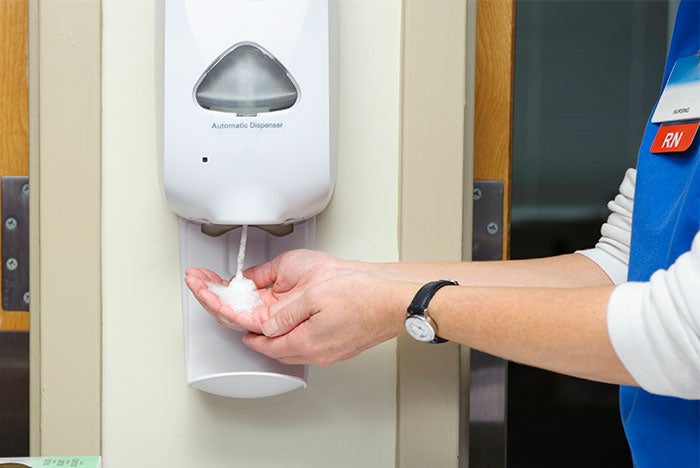Strategies to nudge hand-hygiene compliance

Image from Getty Images
Clean hands are fundamental to keeping both patients and staff healthy, and three recent studies highlight cost-effective ways to prompt hand-hygiene compliance. Findings from these studies indicate that while convenient placement of a hand-hygiene sink or hand sanitizer dispenser is a baseline contributor to encourage hand-washing, various signage can be used to keep good practices top of mind.
A team led by Hansen modified the entryway of a Danish hospital by varying the placement and signage of a dedicated visitor hand sanitizer. Researchers developed 10 different sign and location scenarios. Each scenario was implemented individually, and researchers tracked usage rates for each arrangement by observing more than 46,000 encounters over 50 days. Although all the various combinations improved compliance, placing the sanitizer directly in front of the entrance with a “clean hands save lives” campaign banner demonstrated statistically significant improvements. The greatest improvement in use was when the dispenser was fitted with a sign reading “sanitizer” in white letters on a pink background and placed in front of entry doors behind a pink line of duct tape on the floor. This was an additional visual signal to visitors that hand-hygiene rules applied when crossing the line.
Similarly, a research team led by Mobekk observed hand-hygiene compliance of visitors at a Norwegian hospital. They investigated whether visitors’ hand-sanitizing behaviors changed in response to two different types of signage. The team compared usage of a dispenser with a red sign that read “Here we use HAND DISINFECTANT” to one with a red sign that read “Here we use HAND DISINFECTANT … to protect your relatives.” Researchers noted that while both signs improved visitor use of the dispenser from baseline rates, neither sign was significantly more effective than the other.
Finally, Van Roekel and colleagues took things a step further and used two different cuing strategies to encourage hand-hygiene compliance in the nursing staff of three units at a hospital in the Netherlands. On one unit, they implemented a nudge strategy consisting of a poster that read “in good hands” with a photo of hands being washed. Posters were placed throughout the unit, with flyers placed in high-traffic areas. On a second, similar nursing unit, the team applied a more nuanced tactic called boosting by using a risk literacy strategy. This poster read “prevent infections” and included two statistics related to health care-associated infections in patients. As with the first unit, posters were placed throughout the unit, and flyers were placed in high-traffic areas. The research team anticipated that the boosting strategy would have a more substantial impact on compliance over time, but both the nudge and boost interventions improved hand-washing in the nursing staff with no significant difference in compliance rates between the two.
Suffice it to say that keeping signage relevant and fresh can prompt hand hygiene, but there is more to be learned about what will sustain this health-promoting behavior over time. It would be interesting to note whether it is the content of the signage or the change in signage that makes the most impact in both visitor and staff hand-hygiene practices — either way, lives are saved when hands are clean.
You can find more articles on these and other health care planning and design topics by accessing The Center for Health Design’s Knowledge Repository.
Research used for this column
The following research citations from The Center for Health Design’s Knowledge Repository of health care design resources were used by the author when writing this column:
- P.G. Hansen et al., “Nudging Hand Hygiene Compliance: A Large-Scale Field Experiment on Hospital Visitors,” Journal of Hospital Infection, vol. 118 (Dec. 2021): pages 63–69.
- H. Mobekk and L. Stokke, “Nudges Emphasizing Social Norms Increased Hospital Visitors’ Hand Sanitizer Use,” Behavioral Science & Policy, vol. 6, no. 2 (Jan. 2020): pages 51–57.
- Henrico Van Roekel, Joanne Reinhard and Stephan Grimmelikhuijsen, “Improving Hand Hygiene in Hospitals: Comparing the Effect of a Nudge and a Boost on Protocol Compliance,” Behavioural Public Policy, vol. 6, no. 1 (Jan. 2022): pages 52–74.
About this column
“Design Discoveries” highlights research from The Center for Health Design’s Knowledge Repository, a user-friendly library of health care design resources. This research effort is supported by the American Society for Health Care Engineering, the American Institute of Architects, the Academy of Architecture for Health Foundation and the Facility Guidelines Institute.




